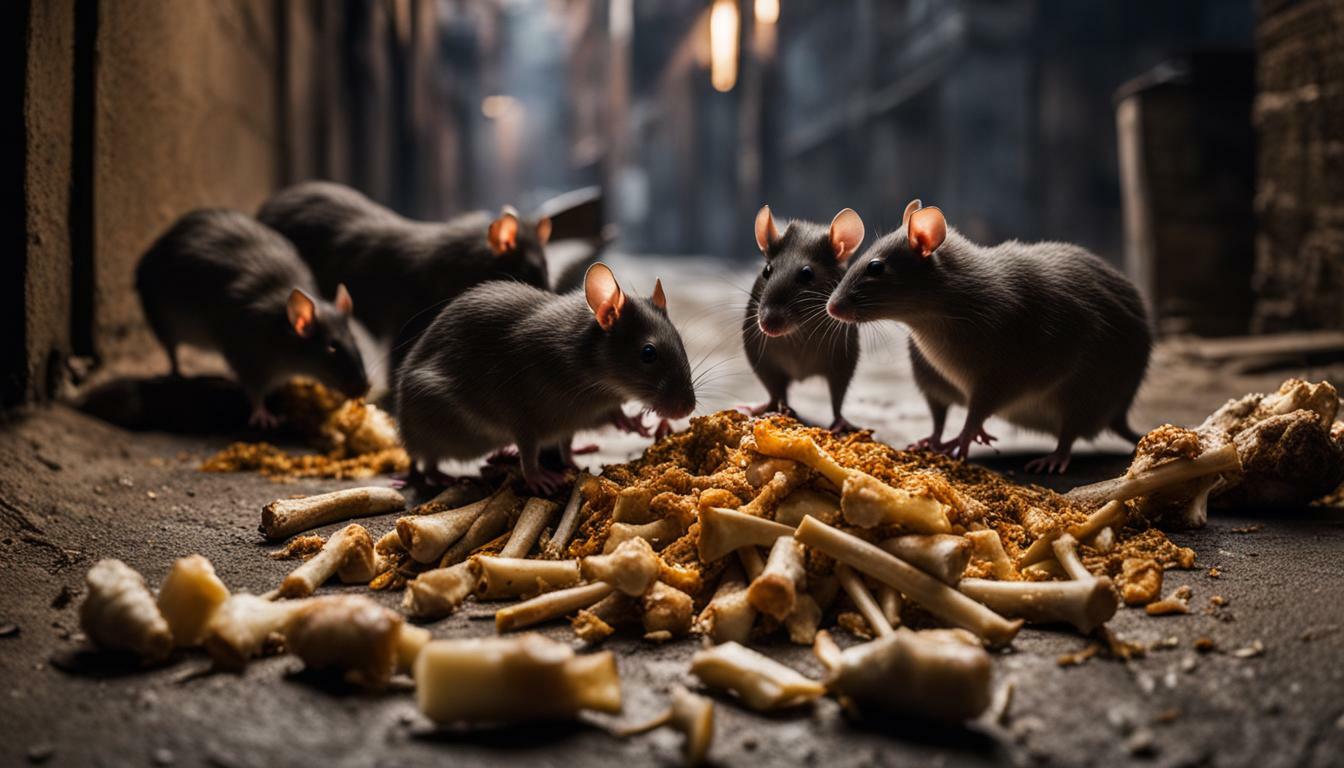If you’re curious about whether rats can eat chicken bones, you’ve come to the right place. In this article, we will explore the topic of feeding chicken bones to rats and provide you with important information about their diet, nutrition, and safety considerations.
Key Takeaways:
- Rats can safely consume chicken bones and derive essential nutrients from them, such as protein, calcium, and phosphorus.
- It is crucial to offer rats fresh, unseasoned chicken bones that have been rinsed before feeding.
- Raw chicken bones are safe for rats, but fried or fatty bones should be avoided.
- Chicken skin can be fed to rats in moderation as a source of fat.
- Other meat bones like pork, beef, turkey, and ham bones are also suitable for rats, as long as they are unseasoned and rinsed.
Rats have effective chewing and digestion mechanisms for bones, and they have a flap in the back of their mouth to prevent swallowing large pieces. However, it is important to note the potential risks associated with splintering, constipation from large bones, and the presence of Salmonella in raw chicken bones. By following proper preparation and feeding guidelines, chicken bones can be a healthy addition to a rat’s diet.
The Rat’s Diet and Nutritional Needs
Before delving into the specifics of chicken bones, let’s first understand the general dietary needs of rats. Rats are omnivorous creatures, which means that their diet consists of both plant-based and animal-based foods. To provide your pet rat with a balanced and nutritious diet, it is important to consider their specific nutritional requirements.
Rat nutrition should include a variety of foods to ensure they receive all the essential nutrients. A high-quality rat food mix, formulated specifically for their needs, serves as the staple of their diet. These commercially available mixes are designed to provide a balanced combination of protein, carbohydrates, fats, vitamins, and minerals. Additionally, fresh fruits and vegetables should be offered daily to supplement their diet and provide important vitamins and fiber.
Rats have a specific need for protein, which can be obtained from various sources. Lean meats, such as chicken and turkey, can be included in their diet to meet this requirement. This brings us to the discussion of chicken bones and their role in a rat’s food intake. Rats can indeed consume chicken bones, which offer nutritional benefits such as protein, calcium, and phosphorus. However, it is crucial to ensure the proper preparation and feeding of chicken bones to avoid any potential risks to your rat’s health.
Now that we have a basic understanding of a rat’s dietary needs, let’s explore the important considerations for feeding chicken bones to rats in the next section.
The Rat’s Diet and Nutritional Needs
| Nutrient | Sources | Recommended Daily Intake |
|---|---|---|
| Protein | Rat food mix, lean meats | 15-20% of total diet |
| Carbohydrates | Rat food mix, grains, fruits, vegetables | 45-65% of total diet |
| Fats | Rat food mix, small amounts of healthy fats | 10-15% of total diet |
| Vitamins and Minerals | Rat food mix, fresh fruits, vegetables | Varies – follow recommended guidelines |
“Rats are omnivorous creatures, which means that their diet consists of both plant-based and animal-based foods.”
- Provide a high-quality rat food mix as the staple of their diet.
- Offer fresh fruits and vegetables daily for added vitamins and fiber.
- Include lean meats, such as chicken and turkey, to meet their protein requirements.
By understanding the nutritional needs of rats, we can better appreciate the role of chicken bones in their diet. In the next section, we will discuss the important considerations to keep in mind when feeding chicken bones to rats.
Important Considerations for Feeding Chicken Bones to Rats
Safety and well-being should always be prioritized when feeding chicken bones to rats. While rats can eat chicken bones, it is crucial to follow certain precautions to ensure their health. Here are some important considerations to keep in mind:
- Always provide rats with unseasoned, fresh chicken bones. Seasonings like salt, garlic, and onion powder can be harmful to their digestive system.
- Before offering chicken bones to rats, make sure to rinse them thoroughly to remove any contaminants or residue.
- Avoid giving rats fried or fatty chicken bones, as they can cause digestive issues and unhealthy weight gain.
- Feeding chicken skin to rats in moderation can be beneficial as a source of fat, but remember to remove any excess fat before offering it to them.
Rats have the natural ability to chew on bones effectively and have a flap at the back of their mouth that prevents them from swallowing large pieces. However, there are still some potential risks to be aware of:
- Splintering: To minimize the risk of choking or injury, avoid giving rats small or brittle chicken bones that may easily splinter.
- Constipation: Large chicken bones can cause constipation in rats. It is important to provide appropriately sized bones that the rats can chew and digest comfortably.
- Salmonella: Raw chicken bones may carry Salmonella, a bacteria that can cause food poisoning. Ensure that the bones are fresh and from a trusted source.
It’s worth noting that other meat bones, such as pork, beef, turkey, and ham bones, can also be suitable for rats as long as they are unseasoned and rinsed properly. When feeding your pet rats chicken bones or any other type of bones, always monitor their behavior and health for any adverse reactions. By following these guidelines, you can safely incorporate chicken bones into your rat’s diet and provide them with essential nutrients.
Nutritional Value of Chicken Bones for Rats
Chicken bones provide essential nutrients that contribute to a rat’s overall health and well-being. These small, crunchy bones are rich in protein, calcium, and phosphorus, making them a valuable addition to a rat’s balanced diet.
Protein is vital for muscle growth and repair, and rats require a consistent intake of this macronutrient to maintain their strength. Chicken bones offer a natural source of high-quality protein that can support a rat’s physical development and overall vitality.
In addition, chicken bones are an excellent source of calcium and phosphorus. Calcium is essential for maintaining strong bones and teeth, while phosphorus contributes to proper cell function and helps regulate energy metabolism in rats. By including chicken bones in their diet, rat owners can ensure their pets receive these crucial nutrients.
| Nutrient | Per 100g of Chicken Bones |
|---|---|
| Protein | 44g |
| Calcium | 800mg |
| Phosphorus | 400mg |
“Including chicken bones in a rat’s diet can provide much-needed protein, calcium, and phosphorus for optimal health.”
Rat owners should ensure that the chicken bones they offer are unseasoned and fresh. It is also crucial to rinse the bones thoroughly before feeding to remove any contaminants. Avoid giving rats fried or fatty bones, as these can cause digestive issues. Additionally, while chicken skin can be fed to rats in moderation as a source of fat, it is important not to overdo it.
Other meat bones, such as pork, beef, turkey, and ham bones, can also be suitable for rats. As with chicken bones, it is essential to provide these bones in their natural state, without any added seasonings, and to rinse them before offering them to your pet. Rats are skilled chewers, and they have a flap in the back of their mouth that helps prevent swallowing large pieces of bone.
While chicken bones are generally safe for rats to consume, it is essential to be aware of potential risks. There is a risk of splintering, which can lead to injury or choking. To minimize this risk, choose smaller, softer bones that rats can easily chew and avoid bones that are too large or dense. Additionally, raw chicken bones may contain Salmonella, so it is crucial to handle them with care and maintain proper hygiene when feeding your rat.
Proper Preparation of Chicken Bones for Rats
Properly preparing chicken bones is crucial to minimize potential risks and maximize their nutritional value for rats. When offering chicken bones to your furry little friends, it is important to follow a few essential steps to ensure their safety and suitability.
Step 1: Choose unseasoned, fresh chicken bones
When selecting chicken bones for your rats, opt for unseasoned ones without any added spices or sauces. Fresh chicken bones are ideal as they are less likely to splinter. Avoid giving them fried or fatty bones, as these can pose digestion problems for your rats.
Step 2: Rinse the chicken bones
Prior to feeding, it is important to thoroughly rinse the chicken bones with water to remove any remaining traces of seasoning or marinade. This helps eliminate potential sources of harm to your rats and ensures that they are consuming clean and safe bones.
Step 3: Monitor the size of the bones
When giving chicken bones to your rats, ensure that the bones are of appropriate size. Too large bones can lead to constipation, while bones that are too small can be a choking hazard. It is advisable to offer smaller bones suitable for their size or break larger bones into smaller pieces.
| Proper Preparation of Chicken Bones for Rats |
|---|
| Step 1: Choose unseasoned, fresh chicken bones |
| Step 2: Rinse the chicken bones |
| Step 3: Monitor the size of the bones |
Step 4: Be cautious of Salmonella
Raw chicken bones can potentially carry Salmonella bacteria. Although rats have a strong digestive system, it is important to be cautious. To minimize the risk, handle the bones with proper hygiene, clean surfaces thoroughly, and refrigerate any leftovers promptly.
Step 5: Observe your rats’ chewing habits
Rats are equipped with efficient chewing mechanisms and have a flap in the back of their mouth that prevents swallowing large pieces of bones. However, it is always wise to monitor your rats while they consume the bones to ensure they are chewing them properly.
By following these steps, you can safely incorporate chicken bones into your rats’ diet. Remember, while chicken bones offer essential nutrients like protein, calcium, and phosphorus, it is crucial to feed them in moderation and alongside a balanced diet to meet all of your rats’ nutritional needs.
Other Meat Bones Suitable for Rats
While chicken bones are a popular choice, rats can also enjoy other types of meat bones as part of their varied diet. These bones provide not only a tasty treat but also valuable nutrients for your furry friend. Unseasoned and rinsed pork, beef, turkey, and ham bones are all safe options to consider. Just like with chicken bones, it is important to ensure that these bones are fresh and free from any seasonings or additives.
Rats have a natural instinct to chew, and meat bones offer the perfect opportunity for them to exercise their dental health. The act of gnawing on bones helps to keep their teeth in proper condition and prevents overgrowth. Additionally, the chewing motion stimulates their jaw muscles and provides mental stimulation, keeping them happy and engaged.
When offering meat bones to your rats, it is crucial to monitor the size and condition of the bones. Large bones may pose a choking hazard, so it is best to choose bones that are appropriately sized for your rat’s mouth. It is also essential to avoid cooked bones, as they can easily splinter and cause injury to your pet. Always opt for fresh, raw bones to ensure the safety and well-being of your rats.
| Meat Bones Suitable for Rats | Preparation Guidelines |
|---|---|
| Pork Bones | Unseasoned and rinsed |
| Beef Bones | Unseasoned and rinsed |
| Turkey Bones | Unseasoned and rinsed |
| Ham Bones | Unseasoned and rinsed |
Remember to always observe your rats while they are chewing on bones and remove any small bone fragments that may break off during the process. By offering a variety of meat bones in their diet, you can provide your rats with a balanced and enjoyable eating experience that promotes their overall health and well-being.
Chewing and Digestion Mechanisms in Rats
Rats possess remarkable chewing and digestive abilities that enable safe bone consumption within their natural diet. These small rodents have evolved to efficiently process bones, using their strong jaws and sharp incisors to break down the tough structure. Their incisors continually grow, allowing for constant gnawing and preventing the teeth from becoming too long. This adaptation is crucial for rats to access the valuable nutrients present in bones, such as calcium and phosphorus.
When rats consume bones, they employ a chewing technique that minimizes the risk of splintering and facilitates digestion. They use a combination of their front teeth and the sides of their mouth to grind bones, ensuring that the pieces are small enough to be safely swallowed. Furthermore, rats possess a flap in the back of their mouth, known as the epiglottis, which acts as a barrier to prevent large bone fragments from entering the respiratory tract.
It is important to note that while rats have efficient mechanisms for bone consumption, certain precautions should be taken. Providing appropriately sized bones is crucial to prevent constipation or gastrointestinal blockage. Large bones should be avoided, as they may pose a risk of obstruction. Additionally, raw chicken bones should be handled with care, as they can harbor Salmonella bacteria. Proper rinsing of the bones before feeding can help reduce this risk.
| Key Points |
|---|
| Rats possess remarkable chewing and digestive abilities that enable safe bone consumption within their natural diet. |
| They use their strong jaws and sharp incisors to break down bones, accessing valuable nutrients like calcium and phosphorus. |
| Rats employ a chewing technique that minimizes splintering and have a flap in their mouth to prevent large bone fragments from being swallowed. |
| Precautions should be taken to avoid constipation, obstruction, and the presence of Salmonella in raw chicken bones. |
Benefits of Rats Consuming Chicken Bones
Feeding rats with chicken bones can provide numerous nutritional benefits. As mentioned earlier, chicken bones are rich in calcium and phosphorus, essential minerals for bone health and overall growth in rats. These nutrients contribute to maintaining strong teeth and bones, and they play a vital role in muscle contractions, nerve signaling, and blood clotting.
In addition to minerals, chicken bones are a good source of protein for rats. Protein is essential for building and repairing tissues, supporting immune function, and providing energy. Including chicken bones in a rat’s diet helps ensure they receive a well-rounded nutritional intake.
It is worth noting that chicken skin can also be given to rats in moderation. The skin provides additional fat content, which is an important dietary component for rats. While rats should not consume excessive amounts of fat, a small amount from chicken skin can contribute to their energy needs.
“The strong chewing abilities of rats allow them to safely consume chicken bones, extracting vital nutrients like calcium and phosphorus. These bones, when properly prepared and served in moderation, can be a healthy addition to a rat’s diet.”
– Dr. Jessica Miller, Veterinary Nutritionist
Overall, when handled and prepared correctly, chicken bones can offer nutritional value and be safely consumed by rats. It is essential to prioritize the well-being of these small creatures by feeding them bones of an appropriate size, ensuring hygienic practices, and consulting with a veterinarian for specific dietary guidance.
Potential Risks and Precautions
While chicken bones can be a healthy addition to a rat’s diet, certain risks should be considered to ensure their well-being. It is important to understand and follow the necessary precautions to avoid any potential harm to your pet rats.
One of the primary concerns when feeding chicken bones to rats is the risk of splintering. While rats have strong teeth and jaws that are capable of gnawing through bones, there is still a possibility of bones splintering and causing injuries to their mouth, throat, or digestive tract. To minimize this risk, it is crucial to offer rats fresh, uncooked chicken bones. Cooked or fried bones can become brittle and more likely to splinter, therefore increasing the danger to your rats.
Another consideration is the size of the bones. Rats should not be given bones that are too large for them to handle. Large bones can pose a choking hazard or lead to constipation if they are unable to be properly digested. Always ensure that the bones are appropriate in size for your rats.
Additionally, it’s important to be aware of the potential presence of Salmonella in raw chicken bones. Salmonella is a bacteria that can cause food poisoning in both humans and animals. To minimize the risk of Salmonella contamination, make sure to handle the bones with clean hands and wash them thoroughly before offering them to your rats. It is also advisable to obtain chicken bones from reputable sources, such as trusted butchers or quality pet food suppliers.
By taking these precautions and being mindful of the potential risks associated with feeding chicken bones to rats, you can provide a safe and nutritious addition to their diet. Remember to always monitor your rats while they consume bones to ensure their well-being and consult with a veterinarian if you have any concerns or questions regarding their diet or health.
| Risks and Precautions for Feeding Chicken Bones to Rats |
|---|
| Risk of bone splintering |
| Size of bones (avoid giving bones too large for rats) |
| Potential presence of Salmonella in raw chicken bones |
Conclusion
In conclusion, rats can safely consume chicken bones as part of a balanced and well-prepared diet, contributing to their overall nutritional needs. Chicken bones provide essential nutrients such as protein, calcium, and phosphorus, which are vital for a rat’s health and well-being.
When offering chicken bones to rats, it is important to ensure that they are unseasoned and fresh. It is also recommended to rinse the bones before feeding them to remove any potential contaminants. Raw chicken bones are safe for rats to eat, but fried or fatty bones should be avoided.
Additionally, other meat bones like pork, beef, turkey, and ham bones can also be suitable for rats, as long as they are unseasoned and rinsed properly. Rats have effective chewing mechanisms and a flap in the back of their mouths to prevent swallowing large pieces.
However, it is crucial to consider some precautions when feeding chicken bones to rats. There is a risk of splintering, which can cause injuries to the rat’s digestive system. Additionally, if the bones are too large, they can lead to constipation. It is also important to be aware of the potential presence of Salmonella in raw chicken bones.
Overall, by offering unseasoned, fresh, and properly prepared chicken bones as part of their diet, rats can benefit from the nutritional value they provide. Always monitor your rat’s health and consult a veterinarian for personalized advice on their diet and nutritional needs.
FAQ
Can rats eat chicken bones?
Yes, rats can eat chicken bones.
What nutrients do chicken bones provide for rats?
Chicken bones provide essential nutrients like protein, calcium, and phosphorus for rats.
How should chicken bones be prepared before feeding them to rats?
Chicken bones should be unseasoned, fresh, and rinsed before feeding them to rats.
Are raw chicken bones safe for rats?
Yes, raw chicken bones are safe for rats to eat.
Can rats eat fried or fatty chicken bones?
It is recommended to avoid giving rats fried or fatty chicken bones.
Can rats eat chicken skin?
Yes, chicken skin can be fed to rats in moderation as a source of fat.
Are other types of meat bones suitable for rats?
Yes, other unseasoned and rinsed meat bones like pork, beef, turkey, and ham bones are also suitable for rats.
How do rats chew and digest bones effectively?
Rats have unique anatomical features that allow them to chew bones effectively, and they have a flap in the back of their mouth to prevent swallowing large pieces.
What are the potential risks of feeding chicken bones to rats?
Potential risks include splintering and the presence of Salmonella in raw chicken bones.




